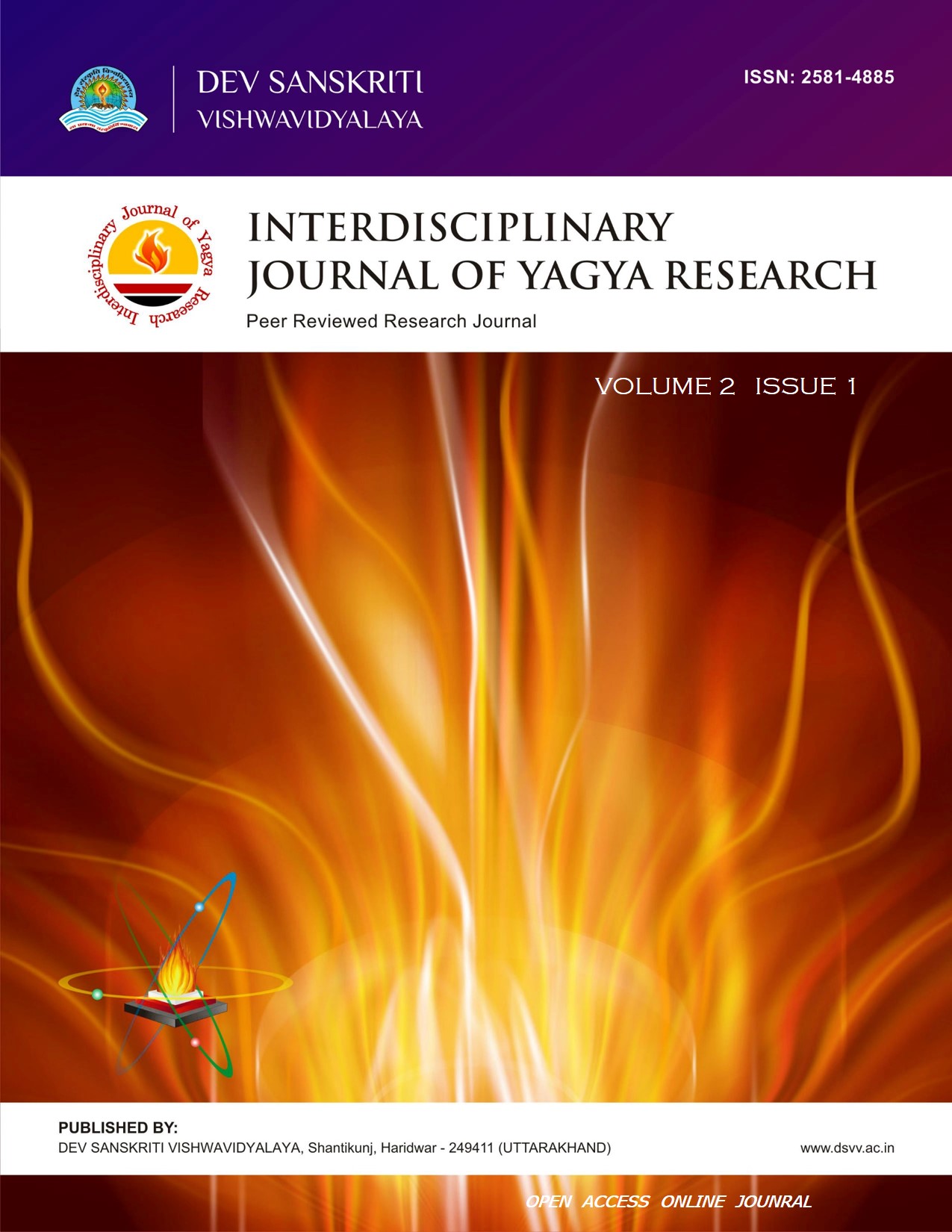Abstract
Yagya or sacrifice has been an integral part of Indian history and culture. More particularly in ancient India, Yagya appears as the backbone of entire social and political structure. Thus, most of the Vedic literature revolves around the sacrificial ritual in different forms for numerous purposes. In contemporary world, when the scientific temperament dominates almost all spheres of life, masses seek to comprehend everything pertaining to human lives in a rational way. However, the recognized truth is that human society exists in a dilemmatic situation where on one hand they are not ready to discard their cultural heritage, customs and traditions and on the other hand they aspire to abide with scientific logic and reason. Therefore, it is essential to trace the philosophy and common logic of one of the most consistent sacrificial practice of Indian culture, i.e. Yagya. And since the Yagya tradition traces its antiquity from the ancient India, there is a requirement to illustrate the historical existence of yagya in abundance. Thus, this paper attempts to comprehensively deal with historical and philosophical aspects of Yagya to understand its relevance in present scenario.
For this study historical methodology has been used premised on the analysis of primary and secondary sources, and the content is descriptive.
Since the time of oldest Indus valley civilization, we find archeological evidences of fire altars from sites such as Kalibagan(Rajasthan), Lothal(Gujrat) etc. which indicate the practice of sacrificial rituals. In entire Vedic literature, plethora of textual references elaborate the philosophy, ritual practice, benefits, norms, the hosts of yagyas, and the various types of sacrifices such as Shraut Yagya (public and royal sacrifices) and Pak Yagya (domestic sacrifices). Furthermore, both literary and archeological evidences enchant the practice and effects of distinct type of sacrifices in later Vedic age, pre-Mauryan period (6th century B.C.), age of empires (Mauryan, Shunga, Satavahana, Kanva, Kushana etc.) and Gupta period. This reveals the historical existence of our cultural tradition.
Moreover the philosophical relevance of yagya (to sacrifice) is exponent as an idea through which Vedic Rishis facilitated the harmony between ecological system and human life, the peaceful co-existence of all the creatures of the universe and their interdependence.
Though it overtly seems that Yagya has been a part of religious life of Vedic Aryans, but after the philosophical and historical analysis, it appears that Yagya crucially contributed to social harmony, constructing political hegemony, and facilitating public welfare in its most intense as well as external procedures. Hence, for dwindling the cultural, environmental and social quos in today’s times yagya needs to be practiced in a modified logical manner.
References
Brahmvarchas, editor. Yagya ka Gyan Vigyan. Mathura: Akhand Jyoti Sansthan; 1995:p1.2
Apte, Vamanshivram. Sanskrit Hindi Kosh. New Delhi: Kamal Prakashan; 1890:P823
Pathik, Indresh. Vedah Pragya Puranancha. Delhi: Parimal Publications; 2012: p224
Bakshi, Mukund Jha, Editor. The Niruktam. New Delhi: Panini Vaidika Granthmala. Vol.12; 1982.
Gaud, Shree Veni Ram Sharma. Yagya Mimansa. 5th edition. Varanasi: Chaukhamba Vidyabhawan; 1999:p5
Shatpatha Brahman 14.3.1.29; Taittiriya Samhita 1.6.10.2.
Bhattacharya, Narendra Nath. Glossary of Indian Religious Terms and Concepts. New Delhi: Manohar Publishers; 1999: p8.
Pandey, Govinda Chandra. Vedic Samskriti. Lok Bharti Prakashan; 2001: p89
Pandey, Rajendra. Bahart ka Sanskritik Itihas. Lucknow: Uttar Pradesh Hindi Sansthan; 2002: p61.
Kane, P. V. History of Dharmashastras. Vol II, Part I. Poona: Bhandarkar oriental Research Institute; 1941:Ch XVIII. p697.
Sharma B, editor. Akhand Jyoti. Mathura, India: Akhand Jyoti Sansthan. 1992;11:p56-57
Ken and other Upanishad. The complete works of Sri Aurobindo Volume 18. Pondicherry, India: Sri Aurobindo Ashram Publication Department; 2001:P275.
Sharma S. (Pt Shriram Sharma Acharya). 108 Upanishad – Gyan khand. Revised edition. Mathura, India: Yug Nirman Yojana Vistar Trust. 2010:p241-242.
Singh, Upinder. A History of Ancient and early Medieval India. New Delhi: Pearson; 2013:p173.
Chakrabarti, Dilip K. India: An Archeological History. New Delhi: Oxford University Press; 2015: p169
Mukherji, Radhakumud. Pracheen Bharat. New Delhi: Rajkamal Prakashan; 1994:p30
Sharma, R.S. India’s Ancient Past. New Delhi: Oxford University Press; 2017; p101
Renou, Louis. History of Vedic India. New Delhi: Sanjay Prakashan; 2004: p143
Luniya, B. N. Evolution of Indian Culture. Agra: Lakshmi Narayan Agarwal; 2003: p66-67
Jha, D.N. Early India; A concise History. New Delhi: Manohar publishers; 2016: p61-62
Jaiswal, Manjula. Valmiki Yugeen Bharat. Ilahabad : Mahamati Prakashan; 1983; p470
Chopra, P N, Puri, B N, Das, M N. A social, Cultural and Economic History of India.vol.1. New Delhi: Macmillan Publishers; 2009:p201
Agrawala, V.S. India as known to Panini. 2nd edition. Varanasi: Prithvi Prakashan; 1963:p367
Mazumdar, Rameshchndra. Pracheen Bharat. Delhi: Motilal Banarsidas; 2002: p94
Mookerji, Radha Kumud. The Gupta Empire. Bombay: Hind Kitab; 1959. p30
Singh, Ravindra. Yagya: Ek Aitihasik evam Vaigyanik Drishti. Interdisciplinary Journal of Yagya Research. 2018;(2):15-21. Available from: https://doi.org/10.36018/ijyr.v1i2.11

This work is licensed under a Creative Commons Attribution 4.0 International License.

